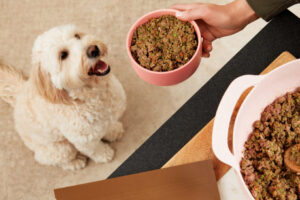
While it is often overlooked by pet owners, dog hygiene is essential. Not only does it keep both us and our dogs comfortable, but it can also help prevent unnecessary sickness and disease. Dirty ears are prone to infections and parasites, for example.
It’s a good idea to keep areas like your dog’s ears, teeth and fur clean. Of course, sometimes keeping your dog hygienic isn’t as easy or simple as you might think. Here is everything you need to know about keeping your dog clean and healthy.
Bathing Your Puppy
We all know that bathing our dogs is important. However, the specifics of bathing your dog can be a bit more complicated. Your dog’s coat type and lifestyle will determine how often they need a bath.
While all dogs need to be bathed every once in a while, some dog’s coats are designed to require baths less often. Dogs with corded coats, like the Puli, don’t require bathing that often at all. They don’t develop a doggie odor and dirt doesn’t tend to build-up in their fur.
Dogs with long hair like the Maltese and Shih Tzu will need a bath every couple of weeks, assuming that their coat is cared for in-between bathing seasons.
Hairless dogs and those with very little hair, like the Chinese Crested, are actually very care-intensive. You will need to bath them on a weekly basis, or even multiple times a week if they come into contact with lots of dirt and dust.
Medium-haired dogs and those with short-hair need to be bathed the least. How much exactly these dogs need a bath depends largely on how much time they spend outside and how much dirt they come into contact with.
When a dog develops the characteristic “doggie odor,” you can bet that it’s time to give them a bath. No matter your dog’s coat type, be sure to use a high-quality shampoo. Cheaper products can contain harsh chemicals, which can dry out your pet’s skin. If your dog has sensitive skin or a health condition related to their skin, be sure to use a specialty shampoo.
Grooming Your Puppy
On top of regular baths, you will also need to brush your canine. Different breeds of dogs need to be brushed for different reasons. Some dogs shed badly and need help getting all of that loose fur out of their coat. Otherwise, it’ll end up all over your furniture and can make your pooch quite uncomfortable.
You should brush these dogs with a metal pin brush or a shedding blade, depending on the density of their hair. For very short-haired dogs, use a bristle brush.
How often you should brush your dog depends on your dog’s coat type. However, it is almost always better to brush them too often than not often enough. Preferably, you should brush any dog at least once a week – more if your dog spends a lot of time outside. Daily brushing is recommended for long-haired dogs or those who spend ample hours outside.
Remember, brushing your dog does not only prevent matting, but it also removes dust and debris.
On top of brushing, you should keep your dog’s ears and eyes clean. You can clean your dog’s ear canal easily with a moist cotton ball. Ear cleaning should happen at least every week, though dogs will floppy ears might need theirs cleaned more often.
You should use a wet cloth to keep your dog’s eyes clean as necessary as well.
Dog Toys at Home
Clean, safe dog toys are essential to your pet’s good hygiene, though they are often overlooked. In fact, dog toys are one of the top ten dirty items in homes according to one study done by the National Safety Federation.
Luckily, many rubber and fabric toys can be put directly into the washer to be cleaned. You can also wash them with hot water and a dish soap like Dawn, just be sure to rinse them well.
Soft toys and those with lots of fabric can be put in the washing machine. Check their tags for specific washing instructions.
You should also wash your pet’s other belongings, including their bowls and beds. Many pet bowls can be thrown into the dishwasher. Others can be hand washed with mild soap and hot water, just like you would wash any other bowl.
You should wash these bowls daily if at all possible, but at the very least give them a good scrub a few times a week. Just like us, dogs can get sick from dirty bowls, which harbor all sorts of bacteria and other nasty things.
Your pet’s bedding should be washed at least weekly, though more might be necessary for heavily used bedding and dogs who tend to get very dirty. Washing their bed doesn’t just keep dirt from accumulating on it. It also gets rid of many of the allergens that dogs drag in. Almost all bedding will have washing instructions on the tag.
If your pet uses blankets, be sure to wash those as well. If your dog tends to lay on the ground instead of on a bed or blanket, keep their usual spot well-vacuumed. Just like a bed and blanket, the spot on the floor that they frequent will get dirty and collect allergens.
Dog Paw and Nail Care
Your dog’s paws need some extra attention when it comes to keeping them clean. You should trim your dog’s nails often. If you begin to hear a “tap-tap-tap” sound while they’re walking on a hard surface, their nails need to be trimmed.
You can do this yourself with a pair of safety clippers or visit a local groomer to have them do it. Many groomers will take walk-in appointments for nails.
The hair between your pet’s paws should also stay trimmed. Otherwise, dirt and debris can easily get stuck in this fur and irritate your pet’s pads. Of course, now is also a good time to check your pet’s paws for injury and irritation.
Oral Care for Dogs
Dental hygiene is also essential for your canines in order to prevent periodontal disease. You should brush your dog’s teeth at least a few times a week to prevent tartar build-up.
They make many different toothpaste flavors and toothbrushes for dogs, so feel free to test a few out to figure out what works best for you and your dog. Get an enzymatic toothpaste, which can help you keep your dog’s teeth clean.
Feeding a high-quality dog food is also great for helping your dog’s teeth stay clean.
Flea and Tick Prevention
Year-round flea and tick prevention should also be part of your hygiene routine. There are plenty of tick and flea treatments on the market. Some go directly onto your pet’s coat, while others are taken orally.
The use of a tick prevention repellent can reduce your and your dog’s chances of vector-borne illness.
You should also check your dog for fleas and ticks regularly. The best place to look for fleas is on a dog’s stomach, as this is the area with the least hair. If your dog has fleas, you will notice tiny, dirt-like dots clumped in the fur. These are actually flea eggs.
Ticks tend to wedge themselves onto ears, in armpits, and along the stomach. They need a place with less hair to access the skin, so check these areas at least once a week and any time your dog spends time in a forested area.
Conclusion
If you want to be a responsible dog owner who finds the best information for your dog, then pet hygiene is essential to your dog’s overall well-being and health. Giving your dog regular baths, caring for their coat, cleaning their belongings, and sticking to a regular flea and tick prevention regimen are all essential.







